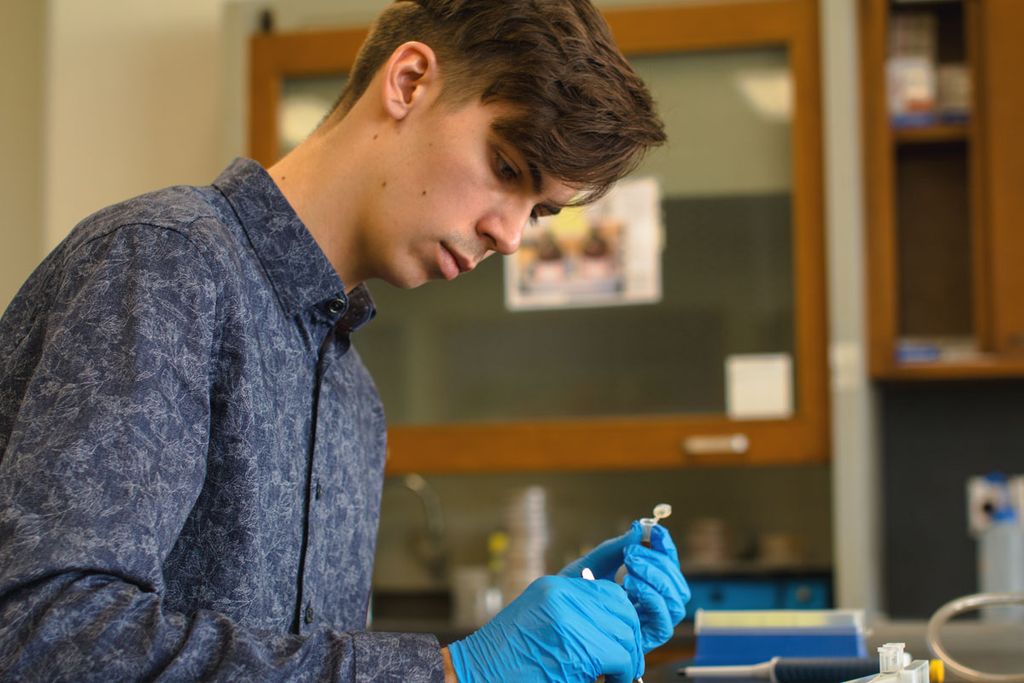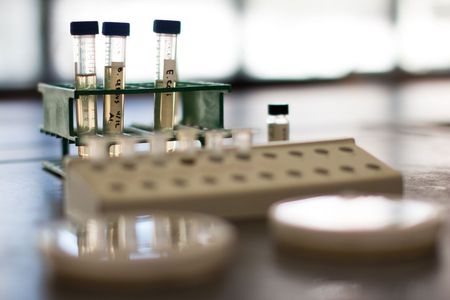Historical Cures
For Native Americans, the black cherry tree was a veritable pharmacy. According to Devon A. Mihesuah, a member of the Choctaw Nation of Oklahoma and author of Recovering Our Ancestors’ Gardens, the root could be used to treat “intestinal worms, burns, [and] cold sores”; its bark brewed into a pain-relieving tea. The Delaware turned the tree’s fruit, also used in cakes, soups, and alcoholic drinks, into a cough syrup.
In a CGS lab, student researcher Adam Lazarchik is breathing new life into this ancient cure-all. Working alongside Sandra Buerger, a senior lecturer in natural science and mathematics, he’s studying folk and traditional remedies, testing their antibacterial properties to see if any could herald a new class of antibiotics. Black cherry tree bark—along with elderberry—is one of those showing early promise.
“Antibiotics are becoming less effective,” says Lazarchik (’18, Sargent’24, SPH’24), “so there’s a huge demand for new antibodies, new molecular compounds that we can use.”
With Buerger’s help, Lazarchik has spent the past four semesters trawling guides to Native American medicine and a mid-19th-century New England pharmacopoeia for timeworn treatments, then testing them in the lab. Their research was supported by the Center for Interdisciplinary Teaching & Learning’s fund for undergraduate research projects, endowed by Mike Gould, the former chairman and CEO of Bloomingdale’s, and the Global Impact Research Award, which is being funded for five years by Gary A. Kraut (CGS’64, COM’66).
“People used things in the past because they were effective,” says Buerger. “Certainly not as effective as medicine we have today, but there was perhaps some measure of protection or help. The ability to optimize that, to understand the mechanism behind it, didn’t exist in the 1700s or 1800s.”
Fighting Antibiotic Resistance
Pursuing better cures is personal for Lazarchik. On Christmas Day 2002, he was diagnosed with liver cancer. He was four years old and spent the next year in treatment. At five, he received a liver transplant.
“It was pretty intense,” he says. “And I’ve been fortunate to be exceptionally healthy ever since my transplant; I don’t have to be in the hospital much more than the average person.”
Although his parents work in healthcare—his mom is a nurse and his dad is in the pharmaceutical industry—that childhood experience “took me even deeper into the medical field. I always had a fascination with the body and how it works.”
During his sophomore year at CGS—and already hoping to pursue a health-focused major—he approached the Center for Interdisciplinary Teaching & Learning about undergraduate research opportunities. They connected him with Buerger.

An expert on microbiology, Buerger is on the hunt for new antibiotics. The world desperately needs them. Previously treatable infections, including pneumonia and tuberculosis, are becoming increasingly resistant to existing antibiotics. The United Nations has warned that by 2050, 10 million people could die every year from drug-resistant diseases.
“What I’ve done in the past is looked at environmental samples—mainly marine sediment and soil samples—to see if there are any potential new antibiotics that exist, which is a difficult thing to do because all of the low-hanging fruit has been grabbed already,” says Buerger.
She says investigating historical cures “fits with this idea of looking for therapeutic agents. We’re at the basic research stage, but the hope would be that if we find something that has this action, we could eventually use it to develop a drug to treat people.”
Buerger acts as a mentor to Lazarchik as he conducts the research, guiding him and helping analyze results, but leaving him to run experiments in the lab.
“Everything Adam takes from his classes, he applies to the lab,” she says. “He’s making suggestions, coming in with new ideas about how to find different substances to test.”
In the video above, Lazarchik and fellow undergraduate student researcher Elizabeth Guerrero (’18, ENG’20) discuss their research on historical cures.
The Promise of Black Cherry
Lazarchik begins each study by sifting through the historical records, placing a mark next to anything that was used to treat infection or inflammation. After checking it hasn’t already been tested by modern-day researchers, he has to make sure it’s still a legal medication. Not all are: blue mass, a compound reportedly used by Abraham Lincoln for constipation (or possibly depression), was made with honey and licorice—and mercury.
Black cherry looked promising to Lazarchik. He brought a small tree into the lab, stripped and ground up the bark, mixed it with water to make a simple solution, and filtered out any bacteria. He conducted a zone of inhibition test, in which he soaked paper discs with the solution and placed them on petri dishes swabbed with different bacteria. A few days later, he looked at the dishes: if there was a clean, bacteria-free ring around the disc, the solution suppressed the bacteria’s growth. The bigger the ring, or zone of inhibition, the more effective its antibacterial properties.
“When we did this with the elderberry and black cherry bark, there was a zone of inhibition, which was super exciting,” says Lazarchik. “Now we’re moving on to create a more concentrated version of those treatments to make sure what we’re seeing is real.”

He says being in the lab has improved his research skills and scientific literacy. When he first started working with Buerger, one of his early experiments didn’t go as planned. Lazarchik spent hours setting the dishes and making solutions, but found the same bacteria’s glowing red colonies growing in every sample. It turned out he hadn’t handled the samples correctly; they were contaminated. Now, he teaches other students how to run studies in the lab and is helping prepare the latest findings for publication.
“Research isn’t always the way people imagine it,” says Buerger. “There are always a lot of setbacks.”
Lazarchik is in BU’s five-year bachelor of science/master of public health program, a dual degree offered by Sargent College and the School of Public Health. After BU, he plans to help create treatments for tropical diseases, particularly those afflicting lower-income countries.
“The health science curriculum exposed me to the fact that there’s a huge equity gap,” he says. “Since I heard about that, I’ve become really passionate about working on that issue.”
But first, he has another ancient remedy to scrutinize: milkweed. The Miwok of northern California used it to heal warts; someday, we might use it to save millions of lives.

1 comment
As a teacher who regularly took her children into the world of the Miwoks, I have long been aware that they had insight into natural remedies provided by the plants in their environment. How brilliant of this team to expand on natural medications and apply today’s scientific knowledge to this idea in the hopes of discovering more effective remedies, especially for people who lack the resources to acquire sorely-needed medications.